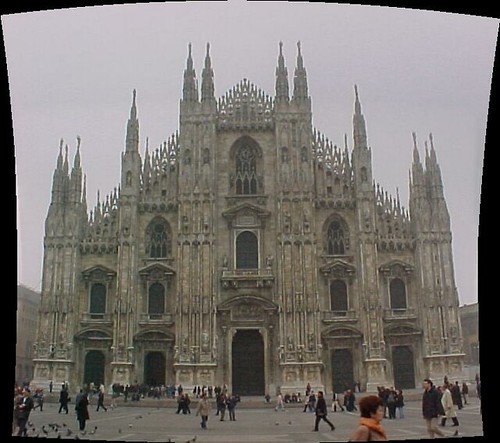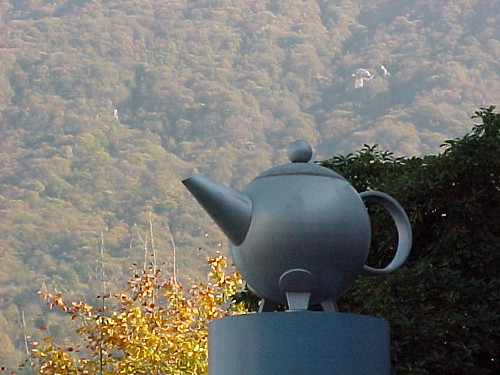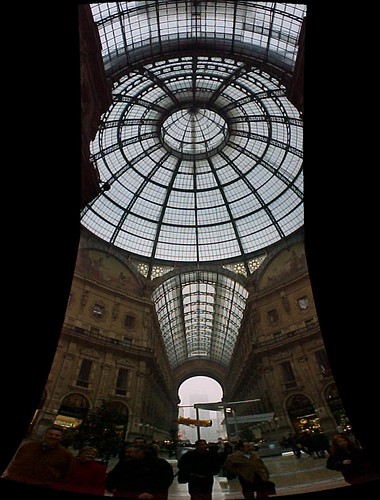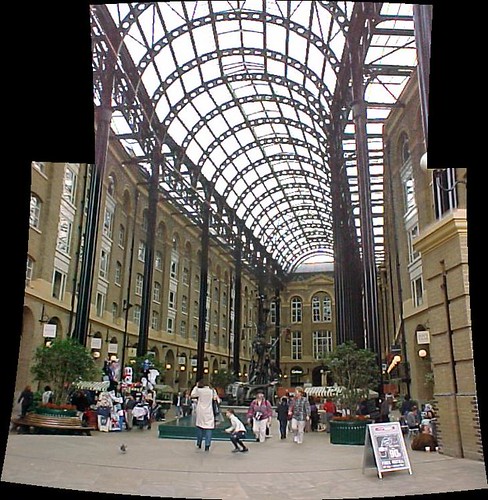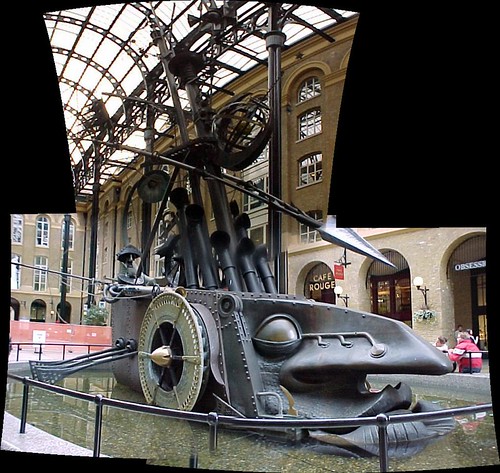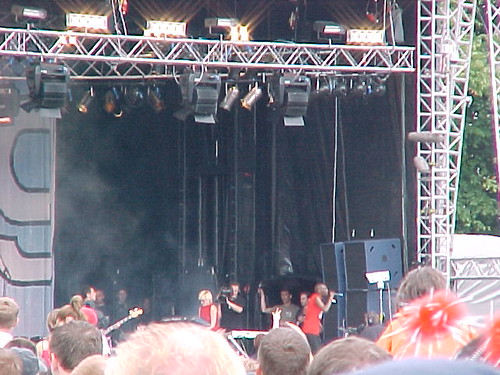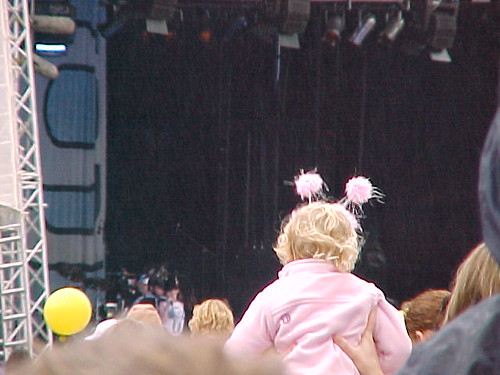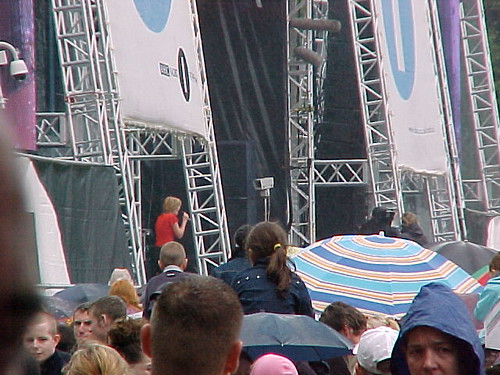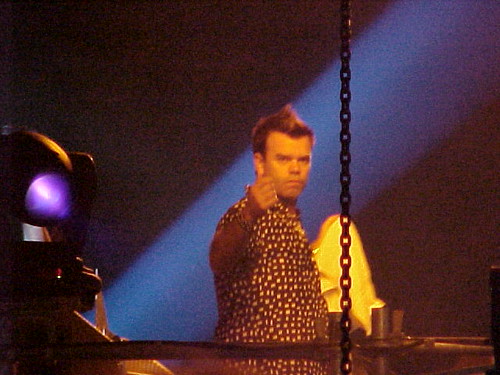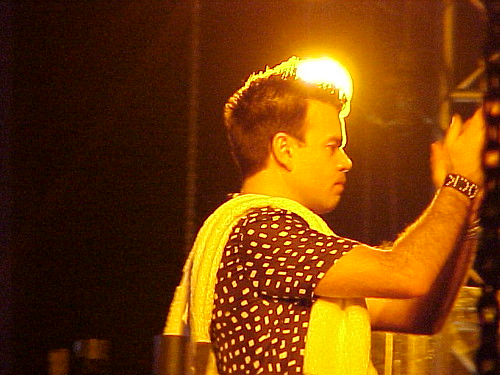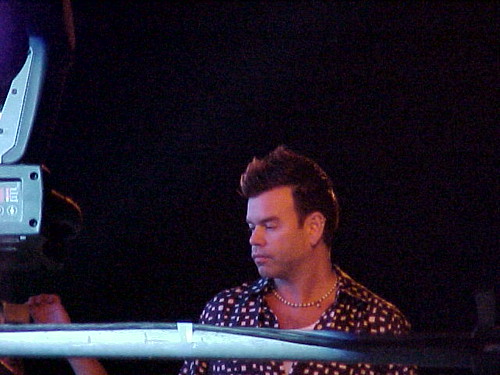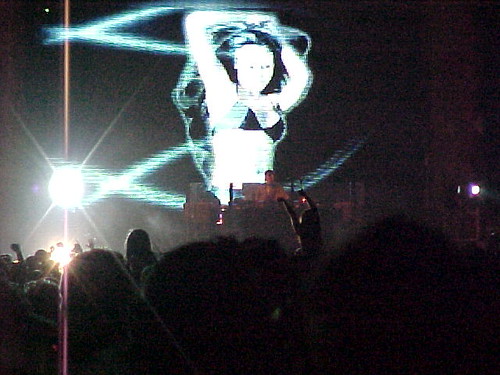Sunday 11 November 2001
Leaning Tower of Pisa, Pisa
Although intended to stand vertically, the tower began leaning to the southeast soon after the onset of construction in 1173 due to a poorly laid foundation and loose substrate that has allowed the foundation to shift direction. The tower presently leans to the southwest.
Leaning Tower of Pisa, Pisa
The Leaning Tower of Pisa (Italian: Torre pendente di Pisa) or simply The Tower of Pisa (La Torre di Pisa) is the campanile, or freestanding bell tower, of the cathedral of the Italian city of Pisa. It is situated behind the cathedral and is the third oldest structure in Pisa's Piazza del Duomo (Cathedral Square) after the cathedral and the baptistry.
Although intended to stand vertically, the tower began leaning to the southeast soon after the onset of construction in 1173 due to a poorly laid foundation and loose substrate that has allowed the foundation to shift direction. The tower presently leans to the southwest.
Monday 5 November 2001
Milan Cathedral (Duomo di Milano), Milano, Italy
Milan's layout, with streets either radiating from the Duomo or circling it, reveals that the Duomo occupies the most central site in Roman Mediolanum, that of the public basilica facing the forum. Saint Ambrose's 'New Basilica' was built on this site at the beginning of the 5th century, with an adjoining basilica added in 836. When a fire damaged both buildings in 1075, they were rebuilt as the Duomo.
Milan Cathedral (Duomo di Milano), Milano, Italy
Milan Cathedral (Italian: Duomo di Milano; Milanese: Domm de Milan) is the cathedral church of Milan in Lombardy, northern Italy. It is the seat of the Archbishop of Milan, currently Cardinal Dionigi Tettamanzi.
Milan's layout, with streets either radiating from the Duomo or circling it, reveals that the Duomo occupies the most central site in Roman Mediolanum, that of the public basilica facing the forum. Saint Ambrose's 'New Basilica' was built on this site at the beginning of the 5th century, with an adjoining basilica added in 836. When a fire damaged both buildings in 1075, they were rebuilt as the Duomo.
Sunday 4 November 2001
Alessi factory, Crusinallo, Italy
Alberto Alessi, Giovanni's grandson, has been heading the company since 1970. He has been credited for recruiting some of the best and most well-known designers to contribute their designs to Alessi's stable of products. These designers include Ettore Sottsass, Richard Sapper, Achille Castiglioni, Michael Graves, Aldo Rossi, and Philippe Starck. It was also Alberto who was responsible for Alessi’s move beyond metalwork to produce designs in ceramic, wood, and plastic. Who else but Alessi would commission Philippe Starck to design a plastic fly-swatter, Dr. Fly, turning an old-fashioned and obscure object into a design status symbol?
Alessi factory, Crusinallo, Italy
Founded in 1921, Alessi has become a renown purveyor of hip, elegant utensils. Combining the slickness of mechanized production with a tradition of skilled, labor-intensive work, Alessi fulfilled the needs and dreams of many design-conscious kitchen owners. Located in the town of Crusinallo, an hour drive from Milan, the Alessi factory is in a region of Italy recognized for its metalwork since the 17th century. Alessi has been a venerable member of that tradition ever since Giovanni Alessi first opened its factory doors.
Alberto Alessi, Giovanni's grandson, has been heading the company since 1970. He has been credited for recruiting some of the best and most well-known designers to contribute their designs to Alessi's stable of products. These designers include Ettore Sottsass, Richard Sapper, Achille Castiglioni, Michael Graves, Aldo Rossi, and Philippe Starck. It was also Alberto who was responsible for Alessi’s move beyond metalwork to produce designs in ceramic, wood, and plastic. Who else but Alessi would commission Philippe Starck to design a plastic fly-swatter, Dr. Fly, turning an old-fashioned and obscure object into a design status symbol?
Saturday 3 November 2001
Galleria Vittorio Emanuele II, Milan
The street is covered over by an arching glass and cast iron roof, a popular design for nineteenth-century arcades, such as the Burlington Arcade, London, which was the prototype for larger glazed shopping arcades, beginning with the Saint-Hubert Gallery in Brussels (opened 1847) and the Passazh in St Petersburg, (opened 1848) and including the Galleria Umberto in Naples (opened 1890).
The central octagonal space is topped with a glass dome. The Milanese Galleria was larger in scale than its predecessors and was an important step in the evolution of the modern glazed and enclosed shopping mall, of which it was the direct progenitor. It has inspired the use of the term galleria for many other shopping arcades and malls.
The Galleria connects two of Milan's most famous landmarks: The Duomo and the Teatro Alla Scala.
More than 120 years after its inauguration, the four-story arcade includes elegant shops selling most things from haute couture to books, as well as restaurants, cafés and bars. Directly connected to the Galleria Vittorio Emanuele II is Milan's ultra-luxurious Town House Galleria hotel, offering the city's most luxurious (and most expensive) rooms and facilities.
The Galleria is the site for many luxury goods' shops, like Gucci, Prada, Louis Vuitton.
Galleria Vittorio Emanuele II, Milan
The Galleria Vittorio Emanuele II is a covered double arcade formed of two glass-vaulted arcades at right angles intersecting in an octagon; it is prominently sited on the northern side of the Piazza del Duomo in Milan, and connects to the Piazza della Scala. Named after Vittorio Emanuele II, the first king of united Italy, it was originally designed in 1861 and built by Giuseppe Mengoni between 1865 and 1877.
The street is covered over by an arching glass and cast iron roof, a popular design for nineteenth-century arcades, such as the Burlington Arcade, London, which was the prototype for larger glazed shopping arcades, beginning with the Saint-Hubert Gallery in Brussels (opened 1847) and the Passazh in St Petersburg, (opened 1848) and including the Galleria Umberto in Naples (opened 1890).
The central octagonal space is topped with a glass dome. The Milanese Galleria was larger in scale than its predecessors and was an important step in the evolution of the modern glazed and enclosed shopping mall, of which it was the direct progenitor. It has inspired the use of the term galleria for many other shopping arcades and malls.
The Galleria connects two of Milan's most famous landmarks: The Duomo and the Teatro Alla Scala.
More than 120 years after its inauguration, the four-story arcade includes elegant shops selling most things from haute couture to books, as well as restaurants, cafés and bars. Directly connected to the Galleria Vittorio Emanuele II is Milan's ultra-luxurious Town House Galleria hotel, offering the city's most luxurious (and most expensive) rooms and facilities.
The Galleria is the site for many luxury goods' shops, like Gucci, Prada, Louis Vuitton.
Friday 2 November 2001
Gabriele D'Annunzio's S.V.A. 5 biplane, Cristoforo Colombo Airport, Genoa

Gabriele D'Annunzio's biplane, Cristoforo Colombo Airport, Genoa, originally uploaded by Craig Grobler.
The S.V.A. 5 was a fairly standard-looking biplane, its most recognizable features being the "W" shaped wing struts and the boxy, tapered fuselage that flattened out and practically merged with the tail fin. Powered by a 220-hp SPA 6A engine, it was fast enough and capable enough to take on multiple roles: bombing, reconnaissance, and fighting. It was of conventional fabric-covered wood construction.
Early Italian biplanes, such as the Savola-Pomillo, were unsuccessful. In 1916, designers Umberto Savola, Rodolfo Verduzio, and Celestino Rosatelli started from scratch, and laid out a new aircraft. Societa Ansaldo of Genoa and Turin, "Ansaldo," got the contract to build the planes and started in the prototype in December, 1916. After modifications to the radiator and the tail, the Ansaldo's workers at the Borzoli Mare factory, under director Brezzi, finished the first machine in March, 1917.
Gabriele D'Annunzio's S.V.A. 5 biplane, Cristoforo Colombo Airport, Genoa

Gabriele D'Annunzio's biplane, Cristoforo Colombo Airport, Genoa, originally uploaded by Craig Grobler.
Across the Carnic Alps, the self-styled warrior-poet Gabriele d'Annunzio, flew with eleven Ansaldo biplanes of the 87a Squadriglia, in a dramatic long-distance bombing raid on Vienna, August 9, 1918. They arrived over the ancient capital of the Hapsburgs and rained down a lethal storm of ... leaflets ... encouraging the Viennese to go on strike.
The S.V.A. 5 was a fairly standard-looking biplane, its most recognizable features being the "W" shaped wing struts and the boxy, tapered fuselage that flattened out and practically merged with the tail fin. Powered by a 220-hp SPA 6A engine, it was fast enough and capable enough to take on multiple roles: bombing, reconnaissance, and fighting. It was of conventional fabric-covered wood construction.
Early Italian biplanes, such as the Savola-Pomillo, were unsuccessful. In 1916, designers Umberto Savola, Rodolfo Verduzio, and Celestino Rosatelli started from scratch, and laid out a new aircraft. Societa Ansaldo of Genoa and Turin, "Ansaldo," got the contract to build the planes and started in the prototype in December, 1916. After modifications to the radiator and the tail, the Ansaldo's workers at the Borzoli Mare factory, under director Brezzi, finished the first machine in March, 1917.
Sunday 21 October 2001
Marty McFly's Nike Air McFly kicks from Back to the future

 The original McFly kicks worn by Michael J Fox in the Back to the Future 2. Fans have been clamouring for a pair of these since the 80's.
The original McFly kicks worn by Michael J Fox in the Back to the Future 2. Fans have been clamouring for a pair of these since the 80's.
It seems that finally Nike are rolling into production with kicks inspired by the originals, while over at the Official McFLY 2015 Project, public support is growing for the original design to be mass produced. Visit; http://www.mcfly2015.com/ for more information.
Marty McFly's Nike Air McFly kicks from Back to the future

 The original McFly kicks worn by Michael J Fox in the Back to the Future 2. Fans have been clamouring for a pair of these since the 80's.
The original McFly kicks worn by Michael J Fox in the Back to the Future 2. Fans have been clamouring for a pair of these since the 80's.
It seems that finally Nike are rolling into production with kicks inspired by the originals, while over at the Official McFLY 2015 Project, public support is growing for the original design to be mass produced. Visit; http://www.mcfly2015.com/ for more information.
Saturday 20 October 2001
A Marc Newson Alu Felt chair at the Design Museum
Armchair with reinforced fibreglass body. Leg in natural polished aluminium. It can be lacquered in various colours for outdoor. For indoor the armchair is available in Feltro, Panno, Hallingdal, Pro, Tonica, Glove, Tonus, leather or leather extra.
Dimensions:
67x106xh.86 cm
A Marc Newson Alu Felt chair at the Design Museum
Marc Newson Felt Chair
Armchair with reinforced fibreglass body. Leg in natural polished aluminium. It can be lacquered in various colours for outdoor. For indoor the armchair is available in Feltro, Panno, Hallingdal, Pro, Tonica, Glove, Tonus, leather or leather extra.
Dimensions:
67x106xh.86 cm
Friday 19 October 2001
A Marc Newson Orgone Stretch Lounge & Alu felt Chairs at the Design Museum
- Marc Newson
Designed in 1993, the Orgone Stretch Lounge, made of aluminium and enamel, is the second artist’s proof from an edition of six plus two artist’s proofs produced by Pod. Orgone is expected to fetch up to a million dollars at auction at Sotheby’s in London this month.
Orgone Stretch Lounge, 400,000 - 600,000 GBP, by Marc Newson for Pod.
Auction at Sotheby’s, London, UK, Saturday, October 18th
A Marc Newson Orgone Stretch Lounge & Alu felt Chairs at the Design Museum
A Marc Newson Orgone Stretch Lounge & Alu felt Chairs at the Design Museum
“The form is one that I was striving for when I made the ‘Lockheed Lounge’ but, in those days, I didn’t have the knowledge or the resources to make it.”
- Marc Newson
Designed in 1993, the Orgone Stretch Lounge, made of aluminium and enamel, is the second artist’s proof from an edition of six plus two artist’s proofs produced by Pod. Orgone is expected to fetch up to a million dollars at auction at Sotheby’s in London this month.
Orgone Stretch Lounge, 400,000 - 600,000 GBP, by Marc Newson for Pod.
Auction at Sotheby’s, London, UK, Saturday, October 18th
Thursday 18 October 2001
HMS Belfast
HMS Belfast
HMS Belfast served throughout the Second World War, playing a leading part in the destruction of the battle cruiser Scharnhorst, and also the Normandy Landings. In service with the Royal Navy until 1965, she was saved for the nation in 1971 as a unique reminder of Britain’s naval heritage.
Wednesday 17 October 2001
Hay's Galleria - London
Hay's Galleria - London
Built in the 1850's, Hay's Wharf took deliveries from ships from all over the world and the area became known as the 'Larder of London'. The great Hay's Wharf complex has been restored to its former glory and those who visit the Galleria today stand on the same spot where the tea clippers from India and China edged their way into the dock 150 years ago.
Tuesday 16 October 2001
The Navigators by David Kemp, Hay's Galleria
The Navigators are high but not dry in a pond in a galleria that was once a wharf in the pool of London. This large sculpture represents the ships, the monsters and the men that drove them, and is animated by a bizarre collection of moving parts, pumps and water features.
Bronze, welded steel, found objects motors, pumps, kinetic and water features
20,000cm x 15,000cm x 14,000cm
£250,000
The Navigators by David Kemp, Hay's Galleria
The sculpture in the centre of the Hay's Galleria is David Kemp's The navigators, 1987
The Navigators are high but not dry in a pond in a galleria that was once a wharf in the pool of London. This large sculpture represents the ships, the monsters and the men that drove them, and is animated by a bizarre collection of moving parts, pumps and water features.
Bronze, welded steel, found objects motors, pumps, kinetic and water features
20,000cm x 15,000cm x 14,000cm
£250,000
Monday 15 October 2001
Sunday 14 October 2001
Thursday 6 September 2001
Jamiroquai on stage at 1 Big Sunday
One Big Summer comes to an end
It's all over for another year! We've had a great summer spending our weekends in some top places across the country, and watching some top acts - and Leicester was no exception... Chris Moyles, The Dreem Teem, Jo Whiley and Nemone brough us 8 top acts for a grand finale!
The Dreem Teem, Coldplay, Kylie Minogue, Nelly Furtado, Dido, Victoria Beckham, Faithless, Craig David and Jamiroquai were all ace, and we've there's reports of the best acts online now to find out what was going on, on stage.
Jamiroquai on stage at 1 Big Sunday
One Big Summer comes to an end
It's all over for another year! We've had a great summer spending our weekends in some top places across the country, and watching some top acts - and Leicester was no exception... Chris Moyles, The Dreem Teem, Jo Whiley and Nemone brough us 8 top acts for a grand finale!
The Dreem Teem, Coldplay, Kylie Minogue, Nelly Furtado, Dido, Victoria Beckham, Faithless, Craig David and Jamiroquai were all ace, and we've there's reports of the best acts online now to find out what was going on, on stage.
Wednesday 5 September 2001
Victoria Beckham on stage at 1 Big Sunday
It's all over for another year! We've had a great summer spending our weekends in some top places across the country, and watching some top acts - and Leicester was no exception... Chris Moyles, The Dreem Teem, Jo Whiley and Nemone brough us 8 top acts for a grand finale!
The Dreem Teem, Coldplay, Kylie Minogue, Nelly Furtado, Dido, Victoria Beckham, Faithless, Craig David and Jamiroquai were all ace, and we've there's reports of the best acts online now to find out what was going on, on stage.
Victoria Beckham on stage at 1 Big Sunday
One Big Summer comes to an end
It's all over for another year! We've had a great summer spending our weekends in some top places across the country, and watching some top acts - and Leicester was no exception... Chris Moyles, The Dreem Teem, Jo Whiley and Nemone brough us 8 top acts for a grand finale!
The Dreem Teem, Coldplay, Kylie Minogue, Nelly Furtado, Dido, Victoria Beckham, Faithless, Craig David and Jamiroquai were all ace, and we've there's reports of the best acts online now to find out what was going on, on stage.
Tuesday 4 September 2001
Dido & Faithless on stage at 1 Big Sunday
It's all over for another year! We've had a great summer spending our weekends in some top places across the country, and watching some top acts - and Leicester was no exception... Chris Moyles, The Dreem Teem, Jo Whiley and Nemone brough us 8 top acts for a grand finale!
The Dreem Teem, Coldplay, Kylie Minogue, Nelly Furtado, Dido, Victoria Beckham, Faithless, Craig David and Jamiroquai were all ace, and we've there's reports of the best acts online now to find out what was going on, on stage.
Dido & Faithless on stage at 1 Big Sunday
One Big Summer comes to an end
It's all over for another year! We've had a great summer spending our weekends in some top places across the country, and watching some top acts - and Leicester was no exception... Chris Moyles, The Dreem Teem, Jo Whiley and Nemone brough us 8 top acts for a grand finale!
The Dreem Teem, Coldplay, Kylie Minogue, Nelly Furtado, Dido, Victoria Beckham, Faithless, Craig David and Jamiroquai were all ace, and we've there's reports of the best acts online now to find out what was going on, on stage.
Monday 3 September 2001
Kylie Minogue on stage at 1 Big Sunday
It's all over for another year! We've had a great summer spending our weekends in some top places across the country, and watching some top acts - and Leicester was no exception... Chris Moyles, The Dreem Teem, Jo Whiley and Nemone brough us 8 top acts for a grand finale!
The Dreem Teem, Coldplay, Kylie Minogue, Nelly Furtado, Dido, Victoria Beckham, Faithless, Craig David and Jamiroquai were all ace, and we've there's reports of the best acts online now to find out what was going on, on stage.
Kylie Minogue on stage at 1 Big Sunday
One Big Summer comes to an end
It's all over for another year! We've had a great summer spending our weekends in some top places across the country, and watching some top acts - and Leicester was no exception... Chris Moyles, The Dreem Teem, Jo Whiley and Nemone brough us 8 top acts for a grand finale!
The Dreem Teem, Coldplay, Kylie Minogue, Nelly Furtado, Dido, Victoria Beckham, Faithless, Craig David and Jamiroquai were all ace, and we've there's reports of the best acts online now to find out what was going on, on stage.
Sunday 2 September 2001
Dido on stage at 1 Big Sunday
One Big Summer comes to an end
It's all over for another year! We've had a great summer spending our weekends in some top places across the country, and watching some top acts - and Leicester was no exception... Chris Moyles, The Dreem Teem, Jo Whiley and Nemone brough us 8 top acts for a grand finale!
The Dreem Teem, Coldplay, Kylie Minogue, Nelly Furtado, Dido, Victoria Beckham, Faithless, Craig David and Jamiroquai were all ace, and we've there's reports of the best acts online now to find out what was going on, on stage.
Dido on stage at 1 Big Sunday
One Big Summer comes to an end
It's all over for another year! We've had a great summer spending our weekends in some top places across the country, and watching some top acts - and Leicester was no exception... Chris Moyles, The Dreem Teem, Jo Whiley and Nemone brough us 8 top acts for a grand finale!
The Dreem Teem, Coldplay, Kylie Minogue, Nelly Furtado, Dido, Victoria Beckham, Faithless, Craig David and Jamiroquai were all ace, and we've there's reports of the best acts online now to find out what was going on, on stage.
Tuesday 28 August 2001
Paul Oakenfold thumbs up!
An extract from Paul Oakenfold: The Authorised Biography by Richard Norris, we recount a memorable free gig at the height of Paul's popularity as a DJ...
Having quit his residency at Cream for the ill-fated Home club in London's Leicester Square, Paul was left without a regular gig and was increasingly looking towards breaking America as his next challenge.
He had pretty much created the concept of the superstar DJ and knew it would work in the States if he put in enough hard graft. Meanwhile his status in the UK couldn't have been bigger, as proved one hot summer's night in London...
Paul Oakenfold thumbs up!
An extract from Paul Oakenfold: The Authorised Biography by Richard Norris, we recount a memorable free gig at the height of Paul's popularity as a DJ...
Having quit his residency at Cream for the ill-fated Home club in London's Leicester Square, Paul was left without a regular gig and was increasingly looking towards breaking America as his next challenge.
He had pretty much created the concept of the superstar DJ and knew it would work in the States if he put in enough hard graft. Meanwhile his status in the UK couldn't have been bigger, as proved one hot summer's night in London...
Monday 27 August 2001
Paul Oakenfold plays Clapham Common
He had pretty much created the concept of the superstar DJ and knew it would work in the States if he put in enough hard graft. Meanwhile his status in the UK couldn't have been bigger, as proved one hot summer's night in London. An extract from Paul Oakenfold: The Authorised Biography by Richard Norris, we recount a memorable free gig at the height of Paul's popularity as a DJ.
“It was f***ing phenomenal,” says Marc Marot. “It was one of the most gobsmacking moments. Channel 4 were completely caught on the hop. By the time there were seventy thousand people there, this supposedly giant screen they’d put up looked like a telly. Paul’s playing to a crowd the size of Glastonbury, and there’s this little screen with a DJ set-up beside it with a small sound system. It was a riot.”
Paul Oakenfold plays Clapham Common
He had pretty much created the concept of the superstar DJ and knew it would work in the States if he put in enough hard graft. Meanwhile his status in the UK couldn't have been bigger, as proved one hot summer's night in London. An extract from Paul Oakenfold: The Authorised Biography by Richard Norris, we recount a memorable free gig at the height of Paul's popularity as a DJ.
“It was f***ing phenomenal,” says Marc Marot. “It was one of the most gobsmacking moments. Channel 4 were completely caught on the hop. By the time there were seventy thousand people there, this supposedly giant screen they’d put up looked like a telly. Paul’s playing to a crowd the size of Glastonbury, and there’s this little screen with a DJ set-up beside it with a small sound system. It was a riot.”
Sunday 26 August 2001
Paul Oakenfold plays Clapham Common
“I played Wembley Stadium opening for U2, but the Clapham Common gig was arguably my biggest ever gig in London,” says Paul.
“This was my gig, and it was free. No one in their right mind expected what went on. It was meant to be people sitting watching the cricket, with a bit of a party after. I was thinking, ‘it’s a nice day, we’ll get maybe ten thousand,’ but the build-up was massive – they changed the advertising, so all over London I had these big billboard posters sup. It became not just a South London event, it became a massive free party for the whole city. The people just didn’t stop coming.”
Things go a bit out of hand at the end, however. Channel 4 had told the Clapham residents that they’d pull the plug at eight, pretty early for an outdoor gig.
“The moment they put the Channel 4 logo on to end the show, bottles and cans started flying, says Marc Marot. “Unfortunately the hospitality area was directly behind the screen – we had to hide while vodka bottles were thumping on the roof, whacking into Channel 4 executives’ cars! It was like Beirut!”
Paul Oakenfold plays Clapham Common
“I played Wembley Stadium opening for U2, but the Clapham Common gig was arguably my biggest ever gig in London,” says Paul.
“This was my gig, and it was free. No one in their right mind expected what went on. It was meant to be people sitting watching the cricket, with a bit of a party after. I was thinking, ‘it’s a nice day, we’ll get maybe ten thousand,’ but the build-up was massive – they changed the advertising, so all over London I had these big billboard posters sup. It became not just a South London event, it became a massive free party for the whole city. The people just didn’t stop coming.”
Things go a bit out of hand at the end, however. Channel 4 had told the Clapham residents that they’d pull the plug at eight, pretty early for an outdoor gig.
“The moment they put the Channel 4 logo on to end the show, bottles and cans started flying, says Marc Marot. “Unfortunately the hospitality area was directly behind the screen – we had to hide while vodka bottles were thumping on the roof, whacking into Channel 4 executives’ cars! It was like Beirut!”
Saturday 25 August 2001
Paul Oakenfold plays Clapham Common
An extract from Paul Oakenfold: The Authorised Biography by Richard Norris, we recount a memorable free gig at the height of Paul's popularity as a DJ...
The channel had just acquired the rights to show the Ashes, cricket’s main draw, from the BBC, and wanted to celebrate in style. The mounted a huge campaign in London promoting the fact, and announced that they would put up a huge screen in Clapham Common for the first England v Australia showdown.
Paul had a friend at Channel 4’s marketing department, who managed to book the DJ to play after the cricket for free, as a favour.
There was only one problem. In the run-up to the event, England managed to lose the cricket series; it was pretty much over by the time the match reached Clapham Common.
Channel 4 had made a commitment to screen the match, and had taken out advertising space all over town. The billboards were changed accordingly – instead of promoting he cricket on the big screen, Channel 4 now elevated Paul’s DJ set to top of the bill.
There was a food stand, a reasonable sized DJ arena, a few toilets, a couple of policemen and a dog. A handful of security guards loitered round the front of the DJ booth.
Everybody was expecting a couple of thousand people to take advantage of this warm summer’s day, leisurely pitching up for some nice tunes in the park. Big mistake. According to the police count, around seventy thousand people turned up.
Paul Oakenfold plays Clapham Common
An extract from Paul Oakenfold: The Authorised Biography by Richard Norris, we recount a memorable free gig at the height of Paul's popularity as a DJ...
The channel had just acquired the rights to show the Ashes, cricket’s main draw, from the BBC, and wanted to celebrate in style. The mounted a huge campaign in London promoting the fact, and announced that they would put up a huge screen in Clapham Common for the first England v Australia showdown.
Paul had a friend at Channel 4’s marketing department, who managed to book the DJ to play after the cricket for free, as a favour.
There was only one problem. In the run-up to the event, England managed to lose the cricket series; it was pretty much over by the time the match reached Clapham Common.
Channel 4 had made a commitment to screen the match, and had taken out advertising space all over town. The billboards were changed accordingly – instead of promoting he cricket on the big screen, Channel 4 now elevated Paul’s DJ set to top of the bill.
There was a food stand, a reasonable sized DJ arena, a few toilets, a couple of policemen and a dog. A handful of security guards loitered round the front of the DJ booth.
Everybody was expecting a couple of thousand people to take advantage of this warm summer’s day, leisurely pitching up for some nice tunes in the park. Big mistake. According to the police count, around seventy thousand people turned up.
Friday 24 August 2001
Notting Hill Carnival - 2001
The current route for the main parade covers around 3 miles, following Great Western Road, Chepstow Road, Westbourne Grove and Ladbroke Grove. In addition to trucks with pan bands or mobile sound systems, there are costumed masqueraders and around 40 static sound systems spread throughout the area playing a range of music at high volume. While the "traditional" Soca and some Calypso can still be found, many other musical styles are represented.
The Notting Hill Carnival actually began in St Pancras and moved around until it found its home. From town halls it has now grown to a huge event, which last year led the Jubilee procession down the Mall.
The Carnival's roots date back to the Abolition of Slavery Act in 1833 when the first Caribbean carnival was held in Trinidad.
Black Caribbeans took to the streets for their own carnival party, with song, dance and costumes.
Notting Hill Carnival - 2001
The 2001Carnival kicks off on Saturday with the Panorama, a competition between steelpan bands mainly from London but more recently including some bands from other areas of the UK. Sunday is Children's Day, with a shorter Carnival route for children and young people. The main parade then takes place on Monday.
The current route for the main parade covers around 3 miles, following Great Western Road, Chepstow Road, Westbourne Grove and Ladbroke Grove. In addition to trucks with pan bands or mobile sound systems, there are costumed masqueraders and around 40 static sound systems spread throughout the area playing a range of music at high volume. While the "traditional" Soca and some Calypso can still be found, many other musical styles are represented.
The Notting Hill Carnival actually began in St Pancras and moved around until it found its home. From town halls it has now grown to a huge event, which last year led the Jubilee procession down the Mall.
The Carnival's roots date back to the Abolition of Slavery Act in 1833 when the first Caribbean carnival was held in Trinidad.
Black Caribbeans took to the streets for their own carnival party, with song, dance and costumes.

